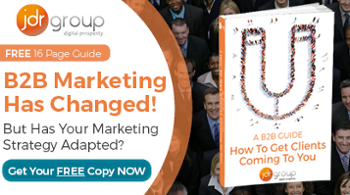How To Attract And Retain Customers With Inbound Marketing

Securing new customers for your business is a great feeling, especially after investing so much into your sales and marketing efforts. Traditional sales models saw signing up a customer as the endpoint of the process. However, inbound marketing views acquiring new business as just one element of an ongoing customer journey. The journey begins with the future customer knowing nothing about your business, develops through targeted content into an initial sale and then continues to progress, until your customer becomes – hopefully – an enthusiastic promoter of your business.
Taking a holistic, long-term view of your customer relationships means having to focus less attention on one-off sales, increases your revenue from each client and generate new leads from referrals.
This article assumes that you already have customers, and covers the best way to develop your relationship so that they turn into promoters. But first, we will look at the stages of the customer journey according to the inbound marketing methodology.
Turning strangers into customers: The inbound marketing methodology
Inbound marketing is the art and science of gaining new business by encouraging your customers to come to you. For online businesses it is the most prevalent and effective form of digital marketing, and covers activities such as blogs, SEO, landing pages and social content. It can be contrasted with outbound marketing, which seeks to bring your brand directly to your customer, by means of PPC adverts, Re-marketing, promotional emails and so on.
For inbound marketing to be successful it is essential that you understand your target market and how they relate to your business.
To this end, inbound marketing defines the businesses in your target market according to five categories:
1) Strangers; businesses in your desired market who have never heard of your company or services.
2) Visitors; who have been attracted to your website via one or more marketing channels e.g. your Youtube channel, a press release, search engine enquiry etc.
3) Leads; who have shown an interest in your business by responding to a call to action, clicking through from a landing page or filling out a contact form, but have not yet made a purchase. In traditional sales speak these people are ‘warm prospects’. They have spent a bit of time on your website and are interested enough to have made contact. They may also be looking at competitors, but at the very least you will be on a shortlist of potential service providers.
4) Customers; who have placed their first order with your business. Congratulations!
5) Promoters; regular customers with an active relationship nurtured through surveys, smart content and social media engagement. This group is likely to actively recommend your services to their network, share your content and show a high level of brand loyalty.
How To Attract And Retain Customers
So, how do you move a prospect from one category to the next? Inbound marketing breaks this journey down into four different processes:
Phase 1: Attract: Stranger to visitor
How do you get people who’ve never heard of you to visit your website in the first place? This is the role of keyword marketing to increase your Google search placement (SEO), engaging your market through an informative blog and creating relevant content that can be shared through social media.
All these activities serve to raise your online profile and make your business more visible.
Phase 2: Convert: visitor to lead
Once a prospect is on your site, you need them to get in touch. For this, you need to cram your website full of relevant content and then make it easy for them to find out more. The marketing activities to focus on are calls to action, contact forms and keyword specific landing pages. Leads can be encouraged to get in touch through special enticements such as a free e-book, newsletter or RSS feed to an interesting blog.
Phase 3: Close: lead to customer
This is where you make your first sale. This can happen through a number of methods, often spontaneously as a result of receiving carefully targeted newsletters and social content. Other leads may need a more direct approach, such as telemarketing or personalised promotions. From your end, the conversion process can be encouraged and managed by using a CRM package and customer relationship workflow. If you're struggling to decide on a CRM, here is a great article - Which CRM Should I Use For My Business?
Phase 4: Delight: customer to promoter
This is where the real magic happens. Through progressive relationship building and positive service, you gradually convert your customer into an enthusiastic advocate for your brand. As this is a proven means of increasing the value and longevity of your customer relationships, the Delight phase is worth looking at in further detail…
Inbound marketing is all about providing your customers with relevant and valuable content, over and above the service you provide them. For a business relationship to flourish, your customers should feel you understand them and value their input. The idea is to actively engage your customers with personalised service and content that will delight them. The result, if done properly, is increased brand loyalty and a greater chance that they will upsell and purchase additional services from you. There is also a higher chance that they will act as promoters by recommending your services to their network of suppliers, colleagues and clients.
There are four tools that inbound marketers use to encourage this:
1) Surveys
If the delight phase is all about giving the customer what they want, the best means of finding out how to proceed is by asking them. Surveys are a tried and tested means of soliciting feedback and understanding what your customers are looking for.
2) Personalised calls to action
Based on your survey results and what you know about your customers, create personalised calls to action and promotions that match the requirements of their business. Most marketers create a series of ‘buyer personas’ to categorise their content. Often referred to as ‘smart content’, personalised content has a greater chance of success and is therefore more cost-effective than a shotgun approach. Examples could include emails tailored to a specific industry or role within a business. For example, you could create a bespoke video and supporting email targeted at procurement managers in the manufacturing industry, and link it to a special discount for this sector.
3) Value-added content
Customers become fans when they understand that you genuinely want them to succeed as a business, and that you aren’t simply after their money. Create content that is relevant to your customer’s interests and challenges. Try and answer their questions and solve their problems – you shouldn’t always be explicitly trying to sell something. At the same time, listen to your customer’s feedback and use this information to develop bespoke products and services.
4) Social monitoring
Social media really comes into its own as a means of engaging in conversations with your target market. Keep up-to-date with the topics your customers search for, the places they visit on Facebook, their comments, shares and likes. Get involved with and play your part in shaping the conversation. This increases your profile as an active participant in your industry, and also lets you know what content your customers are likely to find most relevant. Here is a helpful article which can help you find local customers - 10 Minutes Is All It Takes To Find Your Local Customers Through Facebook.
 Why play the relationship game?
Why play the relationship game?
There is no doubt that inbound marketing takes time. Following the model outlined above does not provide the quick wins of PPC or Facebook advertising. However, as a means of increasing your return on investment, inbound marketing is extremely effective. In a digital economy increasingly focused on relationship building between service providers and customers, it makes good business sense to go the extra mile in providing value for your clients and converting them into long-term promoters for your brand. This not only increases customer retention, but improves the flow of referrals coming into your business.

